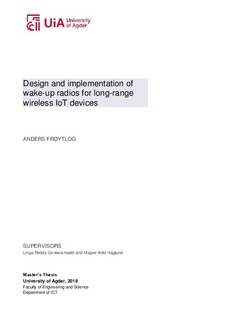| dc.contributor.author | Frøytlog, Anders | |
| dc.date.accessioned | 2019-09-25T12:36:41Z | |
| dc.date.available | 2019-09-25T12:36:41Z | |
| dc.date.issued | 2019 | |
| dc.identifier.uri | http://hdl.handle.net/11250/2618753 | |
| dc.description | Master's thesis Information- and communication technology IKT591 - University of Agder 2019 | nb_NO |
| dc.description.abstract | As the development within Internet of things IoT increases rapidly andthe market starts to utilize its potential, an enormous effort is being madein both academia and industry to optimize solutions according to the mar-ket demands. The demands vary from case to case. Some applicationsmight require relatively high data rate, long battery lifetime, low latencyand long range/area coverage. The numerous use cases and demands for IoTresulted in various IoT technologies. In many IoT applications, especiallyWireless IoT applications, energy-efficiency and battery lifetime are some ofthe most important performance metrics. The wireless access mechanismsused in current technologies utilize Duty-cycling (DC) to reduce power con-sumption. DC allows a node to turn the radio on and off in specific intervalsin order to reduce power consumption.These DC-MAC protocols suffer from overhearing, idle listening or un-necessary transmission of advertisement packets. The different protocolsmay also include long delay time caused by the inactive period in the MACprotocol. The recent research and development of Wake-up Radios (WuRs)addresses some of these problems. A WuR is a simple low power radio re-ceiver which always listens to the channel to detect a Wake-up Call (WuC).A wake-up radio receiver (WuRx) is attached to the main radio which isalways OFF, except when it is supposed to send data. The WuRx and themain radio (MR) are two parts of an IoT node. The use of WuRx eliminatesthe unnecessary power consumption caused by idle listening and reduce theoverhearing consumption as well as the latency. Many articles have beenpublished about WuRs. However, most of the current WuR solutions focuson short range applications. The objective of this thesis is to design a WuRxfor long-range applications, implement a WuRx and evaluate the results andcompare to existing technologies.To reduce the power consumption in long-range IoT applications, aWuRx has been proposed, tested and evaluated. Performance of the pro-posed WuRx integrated with LoRaWAN node is compared to a LoRaWANnode without a WuRx. A DC-MAC protocol which is combined with aWuRx to reduce power is also investigated. | nb_NO |
| dc.language.iso | eng | nb_NO |
| dc.publisher | Universitetet i Agder ; University of Agder | nb_NO |
| dc.rights | Attribution-NonCommercial-NoDerivatives 4.0 Internasjonal | * |
| dc.rights.uri | http://creativecommons.org/licenses/by-nc-nd/4.0/deed.no | * |
| dc.subject | IKT591 | nb_NO |
| dc.title | Design and implementation of wake-up radios for long-range wireless IoT devices | nb_NO |
| dc.type | Master thesis | nb_NO |
| dc.subject.nsi | VDP::Teknologi: 500::Informasjons- og kommunikasjonsteknologi: 550 | nb_NO |
| dc.source.pagenumber | 64 p. | nb_NO |

